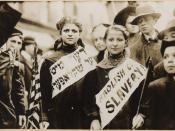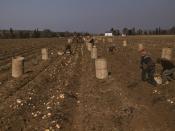Child Labor Laws In The 1800's
Child Labor, once known as the practice of employing young children in factories, now it's used as a term for the employment of minors in general, especially in work that would interfere with their education or endanger their health. Throughout history and in all cultures children would work in the fields with their parents, or in the marketplace and young girls in the home until they were old enough to perform simple tasks. The use of child labor was not a problem until the Factory System. The Factory System is a working arrangement where a number of people cooperate to produce articles of consumption. Some form of Factory system has existed even since ancient times.
In the later part of the 18th century in Britain, owners of cotton mills gathered up orphans and children of poor families all through the country, and had them work for the payment of housing and food.
Some children as young as five or six were forced to work from 13 to 16 hours a day.
Social reformers as early as 1802 tried to obtain legislative restrictions against the worst parts of the child-labor system, but little happened and little was done even to enforce existing laws which limited work hours and establishing a minimum age for employment. Children were permitted to work in dangerous jobs such as mining with the approval from political, social, and religious leaders. From this further impoverishment of poor families and a multitude of diseased and crippled children occurred.
Agitation for the reform steadily increased. The first significant British Legislation was enacted in 1878, when the minimum age of employees was raised to 10 years and employers were required to restrict employment of children between the ages of 10 and 14 to alternate days...


